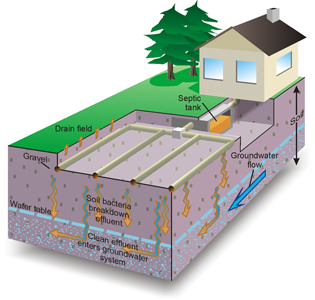Your guide to septic safe plants…
You’ve just installed your new septic system and you’re left with a dirt patch. Or you are tired of the boring green landscape. You want to enhance your curb appeal and keep your yard septic friendly. Here are some tips for septic safe plants and landscaping.
Why Plant On Your Septic System
You may have been scared away from planting on your septic system. And for good reason. Invasive tree roots can wreak havoc on leach fields, but certain plants and landscaping can actually help the efficiency of your system.
Types of Septic Safe Plants
The best septic safe plants for over your system and leach field are short-rooted plants perennials and grasses (including ornamental grass). Grasses and flowers reduce erosion of the soil over your leach field, regulate moisture and can help reduce flooding after heavy rains. And they optimize the exchange of oxygen in the soil needed to filter the last of the bacteria from your wastewater. Their shallow root systems are less likely to invade the underground system and cause damage. Herbaceous (non-woody) ground covers are also a good choice.
Things to consider when deciding what to plant
If the area is sunny, consider these perennials for sunlit areas
If the spot does not get much sun, you will probably be happier with these shade-garden plants.
The soil around leach fields is sometimes wetter than average, sometimes saltier than average, and sometimes both. Cover both bases with perennials such as bee balm, hollyhocks, and wild violets, which tolerate both wet ground and salt.
Bambi will not turn his nose up at plants growing over septic systems, so if you find yourself keeping similar company as Snow White, you will want to look into deer-resistant perennials and deer resistant ground covers, as well as spring bulbs and ornamental grasses that deer do not eat.
It is not safe to eat food crops grown in the ground around a drain field because eating them might entail ingesting harmful bacteria. Any trees or shrubs that you plant should be planted as far from the your septic system as they are tall. So a tree that reaches 30 feet in maturity will need to be planted at least 30 feet away from your septic system.
If you must grow trees and shrubs, shallow-rooted kinds are better to grow around septic tank drain fields. Shallow-rooted trees and shrubs include:
Dogwood trees
Japanese maple trees
Eastern redbud trees
Cherry trees
White Oak
Azalea shrubs
Boxwood shrubs
Holly shrubs
The ideal plant is simple grass, as it take sthe least amount of work and has short roots. If you plant flowers, stick to flowering annual or perennial bulbs with short roots or wildflowers.
If you’re tired of grass try a clover mix (microclover/ecograss/carex pensylvanica dwarf, white clover, carpets (thyme, sedums, low-growing ground covers), shallow, short/soft rooted perennials, and moss)
Try to stick with plants that are native to your area (most of Paradise and Magalia are zones 8 & 9). They will have the best reaction with your climate. For more septic safe trees by zone, check out this link, or consult a local garden center and inform them you are landscaping around a septic system.
The Bad Plants
Deep roots are deadly for a septic system and leach field. They can penetrate and clog pipelines, leach field lines, and the tank itself. Trees and shrubs to generally be avoided include:
Pussy and Japanese Willow Shrubs
Aspen Trees
Poplar Trees
Birch Trees
Beech Trees
Cedar
Elm Trees
Maple Trees (except Japanese Maple Trees)
Sweetgum Trees (Eucalyptus)
Ash Trees
Tulip Trees
Cypress trees
Walnut trees
Bamboo
Stay away from plants that require frequent work, the less you are disrupting the soil the better. There is no need to water your plants more than absolutely necessary, or add soil to the area. Always wear gloves when gardening near your septic system.
Surrounding Area Landscaping
While not in direct contact with your septic system, it is important to landscape the rest of your yard accordingly.
Large trees should be removed from the general area as their roots can spread far and wide. The rule of thumb is to keep all trees at least 100 feet from your home and septic tank.
Use barriers, natural or man made, to discourage traffic over your system. This especially applies to vehicle parking. Make it obvious! Do not park on your septic tank or drain field.
Use mulch, flowerbeds, rain gutters and drains to divert excess water from your leach field.
Just because you have a septic system doesn’t mean your yard has to be barren. It doesn’t even have to be just grass. Stay with septic-safe plants to avoid the headache of a damaged system while enjoying your yard and landscaping.







